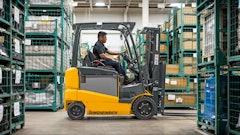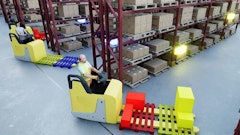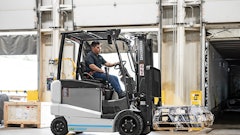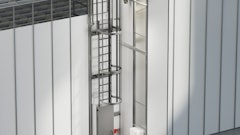Surveys estimate that less than 6 percent of companies can accurately identify their lift truck operating expenses. If the statistic is valid, it stands to reason that effectively managing a material handling fleet without access to the operating expense data is unrealistic.
Operating a lift truck fleet is a reality of your business, but managing a lift truck fleet in addition to focusing on your core business responsibilities can get complicated. Trying to keep tabs on service schedules is tough enough. When you add in the varying degrees of usage of each unit, multiple facilities in different locations, and the possibility of several service providers and parts suppliers, it gets even trickier.
When lift truck fleets are not maintained appropriately or used efficiently, downtime increases, productivity is reduced and you end up with more equipment than you really need. This all affects your bottom line when more and more money is being spent on an aging fleet that doesn’t perform as cost-effectively as it should. Does your company have any one of these issues with your fleet? Then an effective fleet management program might be the answer.
Issues resolved by a sound fleet management program include:
• Underutilized or excess equipment: Comprehensive fleet and facility analysis determines optimum fleet size and best use of each unit.
• High operating costs: Outsourced maintenance programs and parts consignment programs offer cost effective solutions for immediate and long-term fleet expense reduction.
• Specification/configuration inconsistencies: Fleet surveys identify opportunities for commonality of specifications and configurations to provide flexibility for fleet rotation and relocation.
• Aged fleets: Planned replacement programs keep lift truck fleets operating within the optimum economic life cycle.
• Low productivity: Maintenance programs and planned replacement strategies maintain fleet productivity and reduce downtime.
• Mix of makes and models; range of service plans and providers: A single source solution for service and parts, no matter the make or model of lift truck.
• Short-term rentals used to supplement fleets long term: Improved equipment uptime helps reduce the need for short-term rentals; competitive leasing programs can help address acquisition issues.
• Inability to determine and review fleet operating costs: Continuous monitoring and analysis of fleet data ensures strategy remains relevant.
• No formal training programs: Comprehensive operator and technician programs help increase productivity and cut down on equipment repairs, product damage and risk of injuries due to accidents.
A well-defined fleet management program helps determine your overall materials handling costs and identifies ways to reduce them through lower service expenditures and increased productivity. This can accomplish several goals, including:
• Lower operating costs;
• Reduced fleet size;
• Improving or eliminating on-site parts inventory;
• Monitoring costs;
• Reduced supplier base; and
• Maximized fleet efficiency.
Research has shown that only 20 percent of the total cost of materials handling is associated with the price of acquisition. The other 80 percent is directly related to operator and maintenance expenses.
Consider also that on average, companies have 10 percent to 20 percent more units in operation than are necessary to maintain desired productivity. A well-structured fleet management program can help eliminate unnecessary expenses and improve bottom line performance, but without a process in place to capture and analyze maintenance data, effective management of your material handling fleet is not feasible.
Most companies deal with fleet maintenance on an as-needed basis rather than having a formal periodic maintenance (PM) program. A comprehensive PM program is the best way to identify and correct problems while they are small rather than waiting until repair issues have reached crisis mode.
Proper fleet management begins with selecting the right lift truck for the application, tough enough to handle your most difficult loads easily, without giving you more truck than you need.
Planned Replacement Is the Key to Success.
A key component of any successful fleet management program is a planned replacement strategy. As a general rule, lift trucks have an economic life of approximately 10,000 to 12,000 hours. This varies based on maintenance practices, operating conditions and the type of equipment used.
Fleet Management is a step-by-step process that can’t be taken lightly however. A long-term commitment by your company is vital to your success. Follow these steps, and you’re on your way to managing your lift truck fleet.
Step 1: Survey
A complete study of your current fleet helps identify your maintenance costs. Gathering information on the age, specifications, application, usage and condition of each lift truck provides the necessary information to conduct a detailed analysis of your fleet.
Step 2: Analyze
Once the initial survey is complete, utilization studies should be prepared to determine baseline costs and projected service needs. Maintenance history is combined with these results to estimate the opportunity for potential cost savings.
Step 3: Propose
Based on the conclusions drawn from the fleet study, gather recommendations for equipment configuration and replacement, fleet redeployment and maintenance options. Your proposals should also include recommendations for training, parts capabilities, and possible financing alternatives.
Step 4: Implement
Determine a final action plan based on the product recommendations and a product supply strategy. Schedules for training, maintenance and the disposal and replacement of equipment are implemented, and finance options are resolved. Commitment and support are the keys to successful implementation. Effective fleet management programs are not one-time events, but rather are a long-term commitment that provides year-over-year cost savings for your company.
Step 5: Monitor
Each element of the plan is reassessed at regular intervals to ensure your materials handling equipment remains in optimal condition and that hours and usage are reflected appropriately in service schedules. This also enables us to make any necessary adjustments due to changes in your business needs. Ongoing tasks include continuous fleet size review and replenishment, maintenance cost analysis and management reporting.
If this all seems too complicated, or too much to take on, Hyster dealers use the five-step process outlined above everyday to create individualized fleet management programs. From conducting a comprehensive survey of the existing fleet to continuous monitoring of the final strategy, they are a constant source of information, support and service. Here’s how we’ve helped others:
Planned Replacement and Central Purchasing Benefit Food Processor.
A major food processing company with more than 300 locations and 3,000 units needed to centralize material handling procurement and implement a fleet management program. After exploring several options, it turned to Hyster Fleet Services. As a result, the company now has an effective planned replacement program. With central purchasing, it is able to achieve savings through economies of scale and enjoy the benefits of a dedicated account manager.
Fleet Analysis Reduces Paper Company’s Costs.
To help improve corporate return-on-investment, a major paper industry company sought the expertise of Hyster Fleet Services. An annual survey and analysis of its entire lift truck fleet was implemented. The company reduced the average age of its fleet by 50 percent and trimmed fleet size by nearly 20 percent. Savings of approximately $800,000 were realized in the first year, with projections of more than $4 million in cost reductions over the next five years.
Comprehensive Program Provides Auto Manufacturer with Substantial Savings.
Both immediate and long-term savings were the goal of a major automotive manufacturer who turned to Hyster Fleet Services for a fleet management program. A recommendation was made for a planned replacement program, alternative financing solutions, centralized billing and maintenance outsourcing. The result was annual savings of more than $3 million.
For more information, a fleet management brochure or CD, contact your local Hyster dealer or call 888-FLT-SVCS. P.O. Box 7006. Greenville, NC 27835-7006. www.hysterusa.com.
















